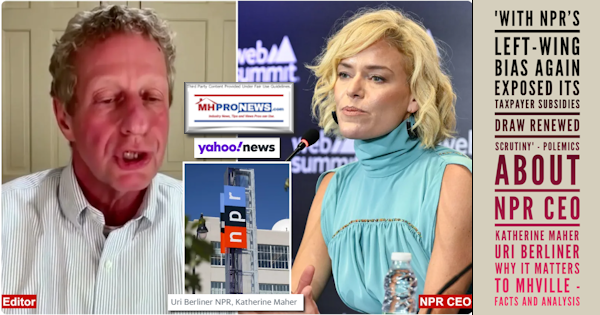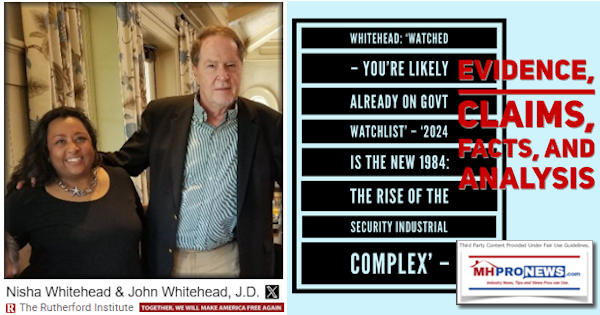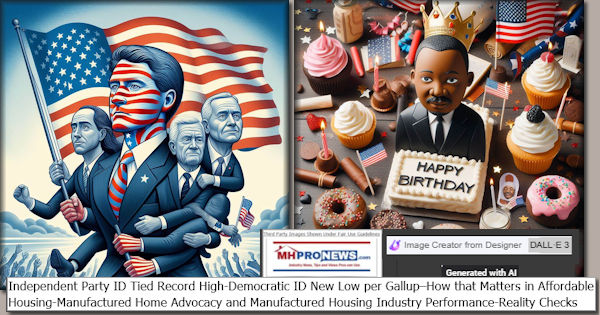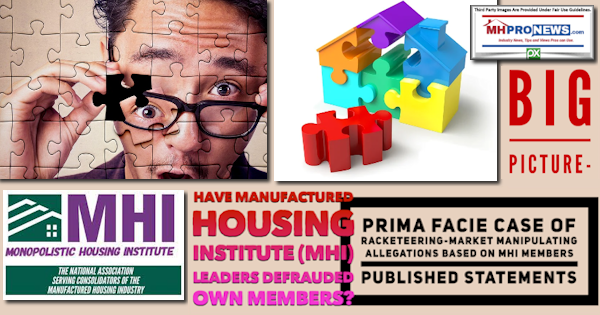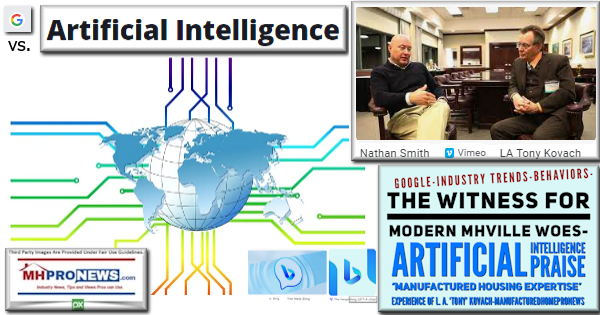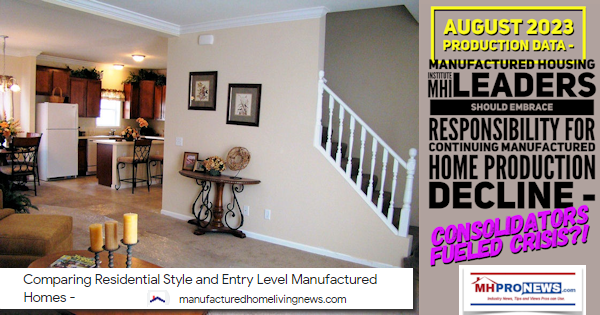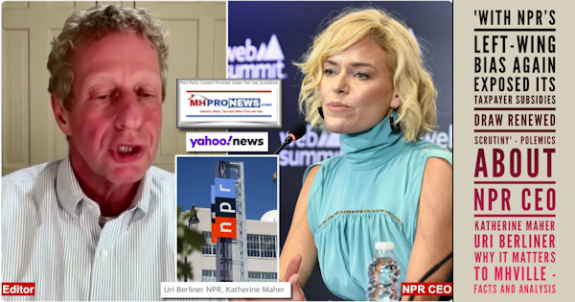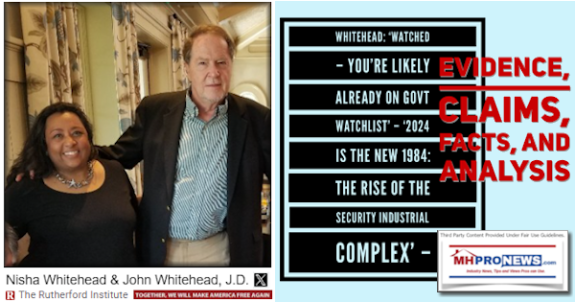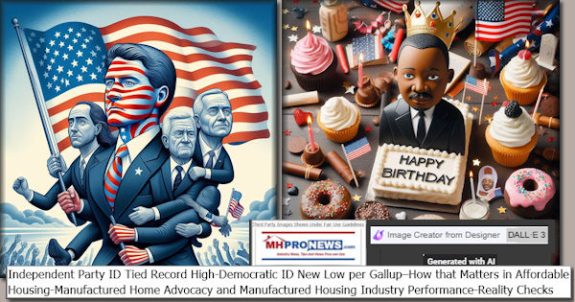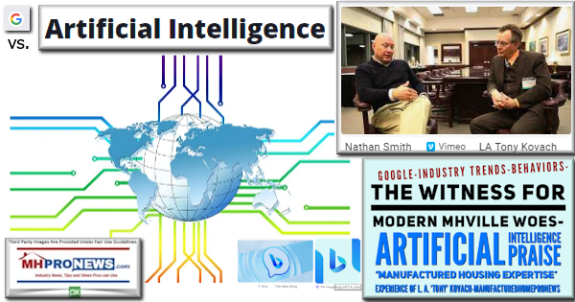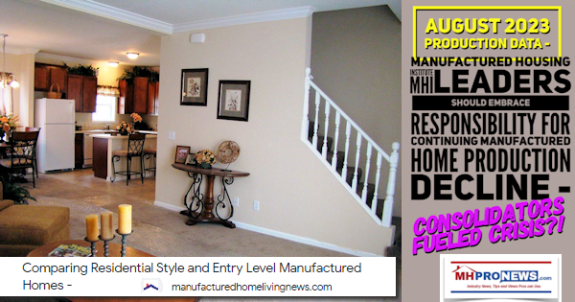Let me begin by saying that MHProNews is highly supportive of HR 1779 as a reasonable remedy to a vexing set of financing and related challenges for manufactured housing homeowners and our industry's professionals. There are state/community association executives who have told me they have made a number of trips to DC this year – in addition to local visits with their Congressman, Senators and respective staffs – to advance the cause of HR 1779. As a bill with bi-partisan support in both chambers, it ought to and can succeed. Please see the Manufactured Housing Institute's (MHI) Chairman, Nathan Smith's call to action message that is linked here.
That said, are we sadly caught up in a larger flytrap?
Let me share an email thread that came into me earlier this week. I'm removing the names of those in the thread, but the rest of the messages are word-for-word as received. This is a 'story within a story,' and is shared with a purpose.
As the context will show, the first email is community owner – an independent 'mom and pop' operation – asking others he addressed for advice about his challenges. It is followed by the first (and I'm showing only the first) reply to this thread. None of these messages are mine.

————– first email from a manufactured home community owner ————–
If a person earns $15.00 an hour and brings home $12.00 of that for 40 hours they will bring home $480 a week x 4 weeks = $1920.00 bring home a month.
Our rule when looking at income vs. expense is roughly this: We don't like to take anyone whose house and lot payment is more than 30% of their bring home. This has become a percentage that seems to make for a long term resident, more than 30% and we have trouble getting our rent.
So, a person bringing home $1920 each month needs to rent for $569 a month- lot and house payment.
Alot of other factors go into our decision after that such as how much their car payments are, child support, credit cards, medical bills, gasoline, food, etc. but still we shoot for 30% for shelter.
If they are seasonal type workers like roofers or landscaping that is a big factor also.
The way I figure it is a home would have to cost about $20,000 to get to that monthly number we need of $569.00 a month.
We know that approx. $8000 covers A/C, skirting, set-up, utility connections, permits, etc.
We know our lot rent is $242 a month.
Ga. sales tax is 7% or $1960
If the home is $20,000 + $8000 + $1960 all that = $29,960.00 with no profit built in for advertising, decor or furniture to show better, my insurance and taxes , electricity, on the home while I own it.
If, and that's a big if, someone had $3000 or 10% down to start the deal, and we can get the bank to finance them, and if they had decent credit, and if I were to go on the note with them and assume the note if they go bad on it, and other stuff, the bank would finance $26,960 for the new owner.
If all that I mentioned above were good with the banker and they loaned the money at 8% for 120 months or 10 years, their payments would be $327 for the house then my $242 for the lot or a total of $569.00 a month.
Maybe 10 years is too short to finance a home, but 20-30 is way too long also.
If a person makes less than $15 an hour, or don't work 40 hours etc. you see where this is going. If the home is not well insulated and say they have at least 2 kids (probably a cat or dog they have sneaked in) and their power bills start hitting $250 a month to heat or cool if the house is not well insulated and gasoline cost keep rising, and food and medical, or they have a car breakdown, you see where we are going.
Currently I'm renting 22 homes, and for the 22 homes my avg. rent is $611 a month and I'm having a heck of a time keeping quality people in them at this price.
In the past 6 working days here is what has happened:
DW- rent was $650- bad health, lost job and moved in with sister- gone
DW- rent is $650- diagnosed with COPD, lost job, moving this Sat. with family
SW- rent is $550- teacher, lost his job, moving in with girlfriend in Huntsville-moving the 13th
DW- rent is $750- works out of town, hinting on moving due to storm fears and high cooling cost, not sure if we are going to keep him or for how long.
SW- Husband died last week of brain cancer, wife does not work and not old enough to draw Social Security, never worked. Expecting her to not pay next month and probably eviction shortly.
SW-SW – two empty homes I'm showing now to sale or rent.
Pretty sure I can't get much of a house for $20,000, so unless we extend the years or lower the interest rate or get more down payment, it's a booger to figure out.
A friend of mine, professional -white collar- both very well educated, both kids out of the house, and both husband and wife making very good money told me the story of him and his wife sitting down one night wondering where their money was going at the end of the month. Where they use to have alot extra to blow, it's not there and they starting looking at the cost of their food, eating out, gasoline, taxes, meds, etc. and found that even they were spending more than they were bringing home. Does it go back to 'its not how much you make buy how much you spend"?
With all this being said, I guess this is why I keep inching my way to the boomer conversation. I've always felt when an older couple downsize they may have funds for a large downpayment or pay cash. They have no kids to drain them each week. They do not impluse buy. They know how much they must have to live on and what they need to pay each month for a house. I think they are tired of mowing and cleaning gutters and want a quality home with good energy saving features. They want to travel and let us mow the grass. So, a two master suite on each end home keeps popping up. If I"m right, then we are not talking about a $20,000 home anymore but double that or more. Baby boomers are coming but I"m not seeing anyone really take aim at them and market to them.
So, a couple of things come to mind. And I'd like anyone to give me some feedback on this and help me clear my thinking or new thoughts on how to go a different route.
I. I need to bring in those who make more than $15.00 an hour
2. I need folks with bigger down payments.
3. I buy used homes, bring them in and renovate them.
4. Finance them longer than 10 years
5. Rent the home
6. Drop 16 wides and go with 14's and smaller in length, and go back to metal/metal.
Maybe in the day and time we live in, just having decent shelter is the best most can ask for right now. Even if it's a 1 bedroom in a nice community, for now that's the most can afford until things change for them.
Unless I have a pool, clubhouse, amentities like some of the rest of you guys and others, I'm not going to draw in the higher end income folks I need?
Looking outside our world, I see McDonalds doing the $1.00 menu. Steak and Shake now expanding their $4.00 meals and all you can eat pancakes for $4.00. Burger King doing a $5.00 lunch bag. Bi-Lo you can earn gasoline reductions, right now we have enough to get 75 cents a gallon off now up to 20 gallons. Apts. not even charging a security deposit, or an animal deposit.
They are changing the way they do business.
In my world I keep thinking my rents are $650 and going up, and getting full deposits, and animal deposits, etc. Buying 16×80's 3/2.
Never have I thought about lowering my cost to bring in business like what I just mentioned above. Are others changing the way they are thinking and lowering their cost to create more volume? Did my affordable style of living become too high while I was looking the other way for the regular working man? Where $650 use to be the norm, now it's $550 or less? How do I become affordable again and have enough income to pay my growing bills? And where can I buy a home that pays for itself in a reasonable time with todays cost of building them? Can a nice energy effecient home be built today for $20,000?
Move my cheese please. Please respond to all and let's see what happens with this.
Thanks
————– reply to above from another MH Community owner/operator ————–
We have found that it is critical to consider not only the “Front-End” Debt-To-Income (DTI) ratio, but also the “Back-End” DTI. Front-End DTI is the ratio of housing costs (excluding utilities) to gross income. Back-End DTI is the ratio of housing costs (excluding utilities) plus other recurring debts (car payment, furniture payment, child support, etc.) to gross income.
At that income level, our acceptable Front-End DTI limit is 30% of gross income. So we would approve that applicant with $2,600/mo. gross income to rent a house and lot for $780/mo.
The problem is that many of our prospective residents have more debt than they can handle – which is not counted in the Front-End DTI. At that income level, our acceptable Back-End DTI limit is 40% of gross income. If that same applicant has a $400/mo. truck pmt. and a $100/mo. furniture pmt., the 40% Back-End DTI would limit his acceptable rent to only $540/mo. – over 30% less than if the only the Front-End DTI is considered.
To complete the underwriting, we verify income, pull credit, get written explanations on derogatory items (we want them to know that we know about the derogatory entries), check rental history, check criminal history, and require applicants to prepare a budget showing that they can afford their new or used home.
When we tightened underwriting several years ago, MH defaults dropped significantly. In fact, in the Lease-Option sale of new MHs over the past 3 years, we have yet to experience the first default.
We all know there are many factors affecting the success of our home sales: configuring the house, pricing the house, lot/site rent, our cost of funds, marketing/advertising, providing the lifestyle our residents want, etc. In my opinion, proper underwriting of prospective applicants is right up there close to the top.
Regards,
————– end of emailed messages ————–
FYI, I know both of the individuals in this thread. So let's presume that they are simply trying to make an honest living, which is my impression of the above.
6 years ago, this would have been a much easier conversation or email exchange to have.
This year, in the current environment, I would ideally want a legal opinion before rendering a direct reply. Even with an expert attorney in such matters at my side, we would both want a lot more detail, because what the second person says in his commentary may be a disguised credit transaction under the law as it exists today. That may trigger $25,000 per incident fines. 10 contracts fined at 25K yields a cool quarter million dollars. Ouch.
There is no doubt in my mind that given a 'free market' with a modicum of common sense regulations, both of these individuals could access straightforward solutions that would serve the public and allow them to make a good living.

From my perspective, I might tell the person who sent the first message above, that yes, he should strive to market and sell up, without ignoring his traditional base of business. That is part of what we teach in our consulting work with retailers, communities and those doing business with the public.
But today, these and thousands of others in our industry are arguably being squeezed by regulations that didn't exist, or were not as stringent, 6 years ago as they are today.

What is the bigger picture issue?
Shouldn't we ask, what sort and size of government do we want to have? What should the relationship be between regulators and those regulated?
Having traveled to Texas a number of times in recent years, and having worked in the Texas market some years back, the relationship between the TDHCA (the state's regulatory agency, Texas Department of Housing and Consumer Affairs, with their Manufactured Housing Division lead by Joe Garcia) is a far more reasonable working one than we see in many other cases.
Is it too much to ask for a good working relationship with regulators and legislators? Not at all.
Costs of Compliance
In a column dated 4.15.2013, The Washington Post had this revealing quote:
“It takes the average American taxpayer 13 hours to comply with the tax code, gathering receipts, reading the rules and filling out the forms the IRS requires. . . . The tax code forces Americans to spend over $168 billion to comply and 6 billion hours.”
-
Rep. Dave Camp (R-Mich.), hearing of the House Ways & Means Committee, April 11, 2013
The Post went onto say that the figures Camp used were based on the IRS's own reports and that of the IRS’ National Taxpayer Advocate. So this is a matter of facts and figures, not party partisanship.
The U.S. Chamber of Commerce cites reports in 2012 that the cost of regulatory compliance is an astonishing 1.7 trillion dollars annually.
I won't go into 'scandal-town' reports, because the media is talking routinely about that based at times upon their unique political perspective. But I will cite a single line from a news-making New York Times editorial, entitled President Obama's Dragnet. “The administration…is proving the truism that the executive branch will use any power it is given and very likely abuse it. “
This is an echo of the our first U.S. President, George Washington, in his farewell address:
“Government is not reason, it is not eloquence — it is force. Like fire it is a dangerous servant and a fearful master; never for a moment should it be left to irresponsible action.”
Yes, we stand with MHI Chairman Nathan Smith's call for manufactured housing industry professionals to focus on getting your Congressman on board with HR 1779 and the 'soon to be filed' Senate version of that bill. That is one reason why we asked Congressman Kanjorski to share tips on how to successfully engage with your Representative and Senators.
But we must not stay in the fly-trap of short term thinking. We must keep on eye on the bigger picture. That bigger picture is that our society has become too complacent regarding big government, whose taxes and regulatory policies per the combined numbers cited above cost our country 1,868 trillion a year. It isn't sustainable, as bankrupt California cities are foreshadowing what will follow if we don't work to change course.
If we circled back to those in writing in that message thread cited above and asked this: if the regulatory environment was less severe – if SAFE Act, Dodd-Frank and CFPB rules became easier – do you think you would be stressing as you are now?
The fact that Manufactured housing can advance even in this regulatory climate is astonishing!
Now imagine how robust our industry could be if we – along with other industries and working people – worked to modify the regulatory environment in common sense ways that would encourage investments and grow jobs. We must learn to think in terms of 'parallel paths.' Yes, focus on HR 1779, but never losing sight of the bigger picture of how much Big Brother costs us all.
Consider this quote from KevinMD in April 2011:
"It is amazing that people who think we cannot afford to pay for doctors, hospitals, and medication somehow think that we can afford to pay for doctors, hospitals, medication and a government bureaucracy to administer it."
– Thomas Sowell
In a nutshell, Sowell hits one of the key realities we must never forget. There is an overhead cost to government. It isn't just the cost to a business of DC's regulations, there are also the costs associated with the people who work at those federal desks. Some think we can never trim this back, there will be too much 'push back' from federal employees. What we must do a better job of is teaching all that a more traditional American economy creates more wealth, not less. There will be more opportunities, not less if we go to the root issues.
Larry Hahn, writing last year in our Industry Voices column, summarized the issues clearly and simply. Take a look at this column, linked here.
.png)
With more opportunities, those workers who are hanging on by a threads in the discussion between the community owners above would be better off than they are today. In booming North Dakota, a McDonald's is paying a $300 signing bonus for a new hire, and are paying roughly double the minimum wage. Why? Supply and demand! Low unemployment, equals higher pay.
We can keep whacking at the weeds as the tentacles of government over-reach spread. Or we can go to the roots of the problems. Yes, let's fix HR 1779, while learning and working to unwind the leviathan that is harming citizens and business owners alike. ##
PS: Check our many Exclusive and Red Hot Featured Articles for June and see the
other new stories at MHLivingNews.com too.
MHLivingNews.com=Re-Discovering and Spotlighting the MHLifeStyle
MHProNews.com = MHMSM.com = Industry News, Tips and Views Pros can Use
Services:B2BandB2CAds, Proven MH Marketing & Sales Systems, Websites other Industry Solutions.
Office –815-270-0500
latonyk@gmail.com or tony@mhmsm.com
http://www.linkedin.com/in/latonykovach= connect with me on Linkedin.
http://pinterest.com/latonyk/manufactured-home-lifestyle/
+++
Whether you think you can or whether you think you can't, you're right. – Henry Ford

